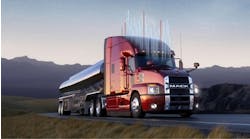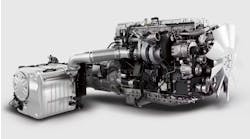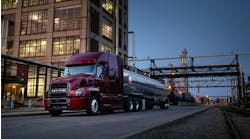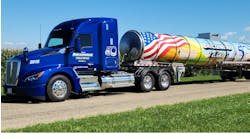Hendrickson invests in solar energy
ConMet marks 30 years of PreSet hub tech
Peterson celebrates 80 years of innovation
Mack Trucks celebrates 125 years
Class 8 truck orders improve in December
VOLVO Trucks showed off some of the latest technology developments for the North American market during a recent media event at its New River Valley plant in Virginia. In the spotlight were improved driver comfort and safety, as well as better fuel economy.
Key product developments included Volvo Dynamic Steering (VDS), Volvo Active Driver Assist 2.0 (VADA), and the next generation of turbo compounding. All of these will be rolled out over the next year.
First launched in Europe in 2014, Volvo Dynamic Steering brings an impressive improvement in driver comfort. A world-class technical innovation, VDS is an ultra-responsive steering system designed to lessen steering force up to 85%, helping reduce driver fatigue and increase road safety. VDS will be available as an option in the Volvo VNL and VNR models in early 2020.
“Drivers are the trucking industry’s biggest assets, and opportunities to increase driver recruitment and retention are top-of-mind for our customers,” said Chris Stadler, product marketing manager, Volvo Trucks North America. “Providing state-of-the-art features that improve drivers’ physical working conditions and comfort is an important aspect of driver satisfaction, as well as increasing overall productivity and road safety.”
VDS is an active steering system that features an electric motor mounted on top of the hydraulic steering gear. Input from multiple vehicle sensors, at over 2,000 times per second, determine the appropriate steering wheel response. The system continuously monitors drivers’ actions, environmental factors and road conditions faster than the blink of an eye. The motor provides additional torque when needed to keep the truck safely on the road. This supports driver reactions with greater control and less abrupt maneuvering.
VDS is ideal for diverse and changing terrains and automatically adjusts to handle any roadway condition. From rough roads to tight maneuvers in urban environments, VDS can help drivers navigate unexpected situations such as pot holes and rapid tire deflations, providing up to nine ft.-lb. of torque in the steering column. Key VDS features include:
Vehicle Stability Control leads to increased directional stability on the highw ay, which offers a more relaxed and safe driving experience with full control at all speeds.
Return-to-Center, or Zero Return enables the steering wheel to return to the center position when the vehicle is in motion, making it easier to reverse the vehicle and maneuver in tight areas.
Dampening allows the steering system to filter inputs from the road surface and, based on feedback from multiple sensors, helps improve handling and vehicle stability.
Lead/Pull Compensation provides a torque offset within the steering system to compensate for crowned roads, steady crosswinds and other short-term conditions that can affect handling.
With more controlled steering, VDS helps reduce operational fatigue by filtering road vibration and noise through the steering wheel. Repetitive motions due to varying roadway conditions and maneuvering actions could cause physical discomfort, which can be lessened when using this system. In fact, testing has shown that VDS has the potential to cut muscular strain by up to 30% and for some specific motions, strain can be reduced up to 70%.
VADA 2.0
Improved driver safety is addressed with the latest upgrades incorporated in Volvo Active Driver Assist (VADA) 2.0, a comprehensive collision mitigation system that will be made standard in the new Volvo VNR and VNL models, and available on VNX models, later this year.
The system enhances the original VADA platform by integrating radar and camera capabilities to help drivers maintain a safe following distance through alerts and improved traffic awareness, as well as emergency braking to reduce the risk of collisions.
“The Volvo Active Driver Assist technology we first introduced with Bendix Wingman Fusion in 2017 was a groundbreaking achievement for increased efficiency and safety through automation,” said Johan Agebrand, product marketing director, Volvo Trucks North America. “Continuing that partnership, we have improved the capabilities of this collision mitigation technology across the board and are confident that VADA 2.0 will further enhance safety for all motorists.”
Available in Q3 2019, with improvements scheduled to roll out through late 2020, VADA 2.0 offers enhancements to many features including:
• Automatic Emergency Braking (AEB) uses camera and radar sensors to determine how traffic is behaving around the truck. When a vehicle is detected, audible and visual warnings alert the driver to take action. If the driver does not respond, AEB engages to mitigate potential collisions. VADA 2.0 expands the capability of AEB beyond the current VADA, allowing it to operate across multiple lanes of traffic.
• Lane Departure Warning (LDW) alerts the driver when an unintentional lane departure occurs. VADA 2.0 allows for adjustable volume and audio mute override options and enables drivers to turn off the system momentarily (10 minutes) for select functions.
• Highway Departure Warning and Braking (HDB) automatically activates if the driver does not take corrective action after a Lane Departure Warning and the system detects that the vehicle may leave the drivable roadway, slowing the vehicle by a pre-defined MPH.
• Adaptive Cruise Control (ACC) with Cruise Auto Resume enables the truck to revert back to cruising speed with Cruise Auto Resume (also known as “Slow & Go”) at speeds above 10 mph, an improved feature in VADA 2.0.
• Driver Awareness Support offers an in-cab windshield-mounted camera with data capture support to enhance driver coaching and data availability.
“We are excited to introduce Volvo Active Driver Assist 2.0 as standard in our truck models, representing the next generation of active safety products,” said Ashraf Makki, product marketing manager-technology, Volvo Trucks North America. “Every feature included in this new technology enables our products to run more efficiently and offers additional safety benefits for our customers and professional drivers.”
Future updates to VADA 2.0 will include Adaptive Cruise Control with Traffic Stop & Driver Go, Lane Change Support with audible alert adjustment, and standalone data capture options without the need for Lane Departure Warning.
Makki adds that VADA 2.0 complements safe driving practices and is not intended to enable or encourage aggressive driving. No commercial vehicle safety technology replaces proactive, comprehensive driver training and a skilled, alert driver exercising safe driving techniques. Responsibility for the safe operation of the vehicle always remains with the driver.
Turbo compounding
VTNA’s next generation of its Turbo Compound technology, providing up to an additional 3% improvement in fuel efficiency over the current 13-liter Turbo Compound engine, will be available in the D13TC. This new engine delivers up to 11% fuel savings overall compared to model-year 2015 trucks, according to said John Moore, product marketing manager at Volvo Trucks North America.
Other improvements include enhanced efficiency over a wider range of applications, more engine ratings, and a new EE Extra Efficiency drive mode. The new D13TC will be available for order in the fourth quarter of 2019 and go into production at the end of the first quarter of 2020.
“We developed our first generation of the Turbo Compound engine in 2017, and since then almost 300 million miles have been logged, validating the up to 8% fuel-savings benefits,” Moore said. “This new D13TC builds upon this game-changing engine technology, further increasing fuel efficiency by up to 3% over the current D13TC engine, saving approximately $1,200 per year per truck, based on the average fuel price and 125,000 miles per year.”
Volvo Trucks’ new D13TC offers three individual drive modes, Dynamic Torque, an additional 405 horsepower rating, and the next evolution of the Volvo Trucks’ patented wave piston design.
These updates enable further-increased fuel efficiency over a wider range of loads, vehicle speeds and engine RPMs. This offers a broader use of applications compared to the first generation of the D13TC engine, which was designed specifically for over-the-road, long-haul applications for trucks loaded at 80,000 pounds. The latest generation of Turbo Compound engine should have a wider appeal for bulk haul applications, according to Moore.
The three individual drive modes available with the new D13TC engine are Extra Efficiency, Economy, and Performance. These modes will allow the driver to better optimize fuel efficiency for the vehicle with desired performance, depending on application, topography and driving conditions. This new engine also features a wider RPM efficiency band, which enables top fuel efficiency for longer periods of time.
Dynamic Torque is an incremental torque system designed to provide the right torque at the right time. Rather than operating in silos of high-torque and low-torque modes, Dynamic Torque automatically sets a torque level dependent upon the weight of the truck, the grade and the road conditions at any given time. Dynamic Torque also features an automatic 12th gear lockout on heavy loads with Adaptive Gearing engine ratings. A kick-down switch along with performance drive mode allow access to full torque for customers requiring it on demand. This simpler, more effective system on the new D13TC engine will provide an even more consistent improvement in fuel efficiency across different applications, enabling customers to cut costs on a wider range of operations.
The new engine also features a revised wave piston, designed and patented by Volvo Trucks. The improved design optimizes wave technology to evenly distribute the air/fuel mixture in the cylinder, burning the fuel more consistently than a traditional piston. Volvo’s design increases the compression ratio from 17:1 to 18:1 while maintaining up to a 90% reduction of soot in the cylinder, further improving fuel efficiency in the engine.
“The individual drive modes allow drivers new heights in fuel efficiency without sacrificing performance,” Moore said. “We are also taking it to the next level with a simpler torque package that delivers the right torque at the right time. Not only is it cutting edge when it comes to sustainable use of diesel in the transportation industry, but it is the most fuel-efficient Volvo engine on the market for our customers, with trucks running cleaner at a reduced cost.”








